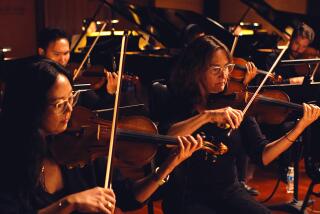Accompanist Provides the Sound of Silents
- Share via
If you pack a flashlight and head for the Paramount Ranch for the “Silents Under the Stars” mini-festival that begins Sunday, you’ll hear more than crickets and coyotes. Composer Michael Mortilla will be at the keyboard, providing the musical accompaniment for the film.
Mortilla, 42, isn’t there simply to tickle the keys at a few crucial moments. The UC Santa Barbara faculty member is building quite a reputation for his accompaniment, and some fans come to hear him as much as to see the classics.
The amazing thing about Mortilla is that when he sits down at the keyboard and the film begins he is often seeing it for the first time. In other words, he creates the music on the spot, without a clue to the plot.
“What I do best in music is improvise,” said Mortilla, who lives in Santa Barbara.
It’s not for anyone whose brain and fingers work at less than lightning speed. Sometimes the movie will start in a serious vein, and he will respond likewise. But then, the tables might turn and he’ll think: “Oh my gosh, this isn’t a tragedy, it’s a comedy.”
Ask him about the scene where the villain took one full minute to finally fall off the cliff. “My left hand was going like crazy, and my right hand was waiting for the fall.” But some parts of the plot are predictable. “There’s almost always a marriage at the end,” he said.
Mortilla uses an electric piano for accompanying the silent films. With computer assistance, he can program sounds, like a baby crying, clocks or gunshots. Sometimes a plot summary of the movie gives him some clues. When he accompanied the movie “Zorro,” he surprised the audience when he played the sound of a whip cracking.
But sometimes he has more to worry about than following the plot. Playing outside presents some surprises, like the time fire ants attacked his foot during the performance. Then there was the time a moth landed on the lens of the projector, casting a blob on the screen.
“I thought it was in the film,” he said. “I thought it was a reptile.”
Mortilla has been musically involved with silent films for 10 years. He was tuning a piano for a Santa Barbara woman when he slipped into a rag tune, and she suggested he might be good at supplying musical accompaniment for silent films.
He was, and since then he has made quite a name for himself. He has accompanied well over 100 silent films. His most famous silent-film stint was to provide new scores for 12 restored Charlie Chaplin films for Los Angeles-based Film Preservation Associates.
He recently finished the score for the Chaplin film “Easy Street,” which will be played live by a 70-piece orchestra as part of a historical project on cinema featured during the Olympics in Atlanta this month.
“Silents Under the Stars,” now in its eighth year, is staged at the Paramount Ranch by the Silent Society of Hollywood Heritage Inc. and the National Park Service, which has owned the movie ranch since 1980.
The films are shown in the open-sided building known as the pavilion, which was built by Paramount Studios to house props during the 1920s and ‘30s when the movie ranch was in its heyday. The huge ranch’s canyons, oak groves, streams and rolling grasslands provided the backdrop for the movies made by the studio until the late 1940s.
Today the cameras still roll on what remains of the Paramount Ranch. The TV series “Dr. Quinn, Medicine Woman,” is filmed there. Moviegoers can explore the western sets at the ranch before the film begins. Some people like to be there when the sun begins to set and the cool night air is filled with the sounds of nature.
“By the time the film ends,” Mortilla said, “it sounds like 300 children laughing. What those are are coyotes.”
More to Read
Only good movies
Get the Indie Focus newsletter, Mark Olsen's weekly guide to the world of cinema.
You may occasionally receive promotional content from the Los Angeles Times.










